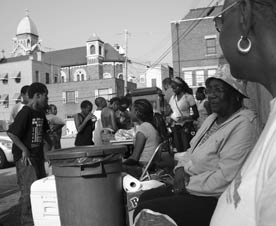I wasn’t sure how long it would take me to get acclimated to the life of a community organizer. I was a little uneasy about going to residents’ homes to talk to them about crime, health, and poverty issues. But like anything else, the comfort comes in the practice.
Through weeks of training and shadowing my partners as they canvassed neighborhoods, I got the hang of walking to someone’s door while surveying the environment for any potential concerns. Shaking the fence to announce your presence to dogs before you enter someone’s yard was one of the first lessons learned at a two-hour training on how to move safely through the neighborhood. After a while you memorize your talking points and you figure out how to hold the clipboard and 30 pamphlets filled with resource information, all the while taking down comments from residents, sometimes in freezing or scorching-hot temperatures.
The resource materials given to residents cover a wide range of topics, from after-school programs for kids to a police sketch of a serial rapist. I respond to residents’ concerns and provide information about city services, job fairs, community resources, and phone numbers to call in times of trouble — whatever residents express a need for. Every house you visit must be noted so that a tally can be kept to insure partners are reaching their goals of a specific amount of contacts per week. Each partner is responsible for a sector of the city and must keep accurate weekly reports on how many people he has helped and how. In order to retain funding, each fiscal year the organization is held accountable for achieving quality outcomes.
Because I am a member of the Public Allies program, I share a sector with another community partner. While all community partners are responsible for weekly reports for Safe & Sound, I have my own reporting system called PISD (Personal Impact Service Document) through AmeriCorps.
While knocking on doors is an important part of community outreach, it is only a fraction of the daily responsibility. Some of the duties a partner must perform include establishing block clubs, organizing neighborhood clean-ups, providing community-service opportunities for youth offenders, and facilitating events with residents. A Community Partners event can range from a neighborhood walk to a conflict-resolution meeting, known as a “peace circle.” Often partners are assigned special projects to assist with quality-of-life issues. For example, Julie and I conducted housing-code surveys in October 2007. We organized an initiative in which partners were required to collectively document a minimum of 300 housing-code violations throughout the city, a task that brought its share of agitated phone calls and voice-mail messages from residents.
Perhaps my largest and most ambitious task to date is a lead-abatement initiative, encompassing five community-outreach events for which Julie and I were responsible. Each outreach event consists of local kids walking their neighborhoods and talking to residents about the dangers of lead poisoning. The first outreach involved high-school age students from the Boys & Girls Club in Milwaukee’s Sherman Park community. The youth group received a brief training on the health risks of lead as well as on community organizing before going door to door. Four more events are being scheduled for the spring in areas of the city identified as at high risk for lead poisoning.
I was just a few weeks into the job when I went to my first Community Prosecutors Unit (CPUT) meeting and realized that this is exactly where I was meant to be. At CPUT meetings, members of Community Partners meet with law-enforcement officers and representatives of the District Attorney’s office to discuss issues pertaining to crime and violence. After several of these gatherings and my first crime-analysis meeting at police headquarters, I had what an alcoholic might call a “moment of clarity.” There is an entire world out here that I know nothing about. What were merely streets with names and blocks with numbers became human beings.





Comments